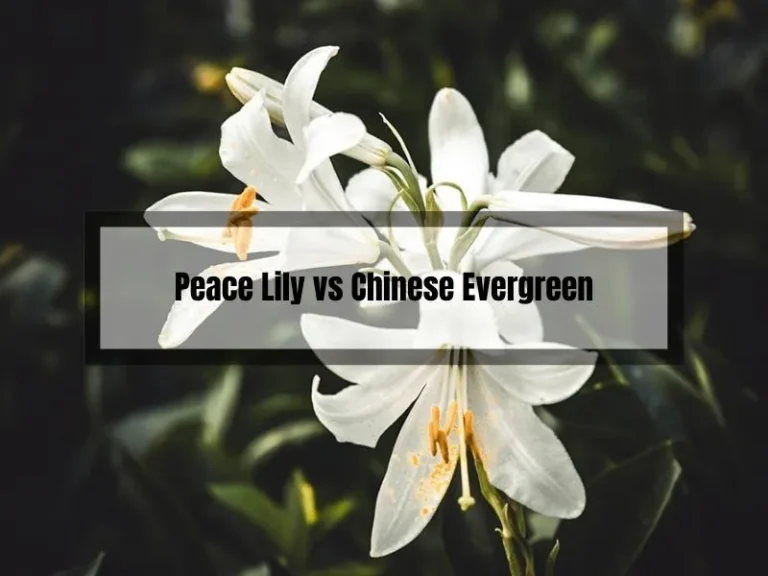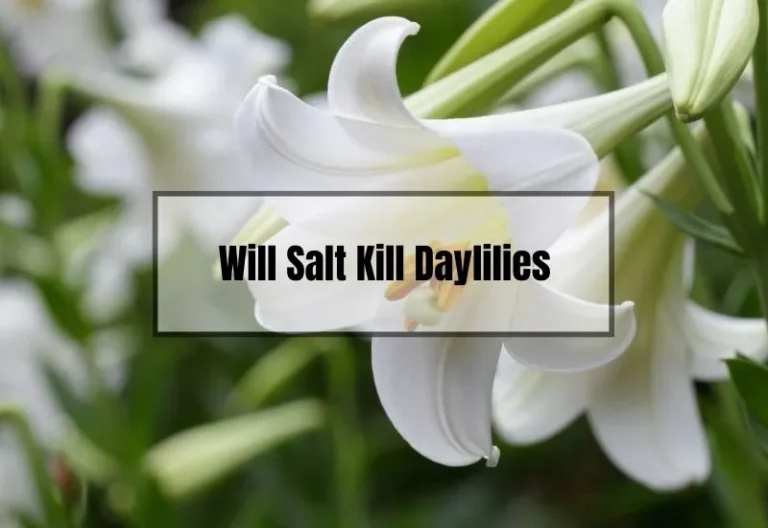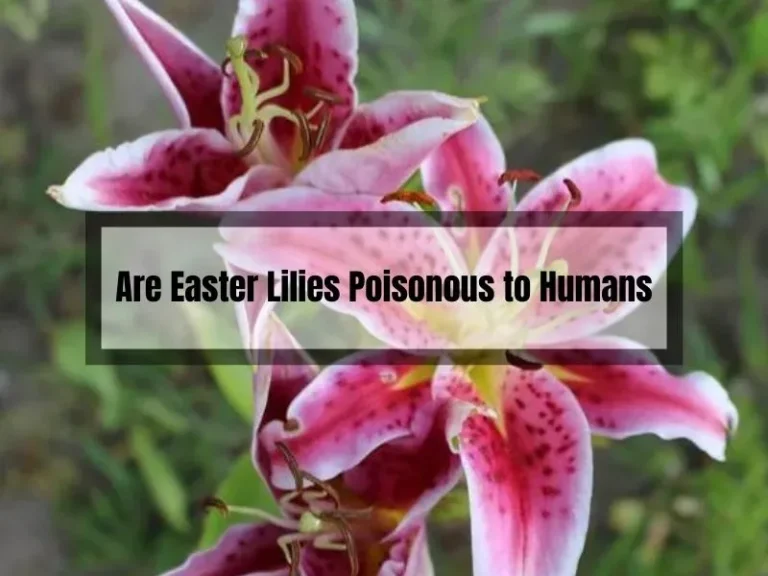Peace Lily vs Easter Lily: Which Plant is Best for Your Home?
Hey there, plant enthusiasts! Have you ever found yourself admiring the elegant blooms of a peace lily or an easter lily, wondering which one would be the perfect addition to your home?
Well, you’re in luck! In this blog post, we’ll dive into the world of peace lilies and easter lilies, comparing their appearance, growing conditions, toxicity, and more.
So, let’s get started and help you make an informed decision on which of these beautiful plants will be the star of your indoor garden. Trust me, I’ve been through this process, and I’m here to share my experiences and insights with you.

Peace Lily vs Easter Lily: The Main Differences
As a plant enthusiast, I have always been fascinated by the differences between Peace Lily and Easter Lily. While both plants are beautiful and have their own unique qualities, there are some key differences that set them apart.
Firstly, Peace Lily (Spathiphyllum) is a tropical plant that thrives in warm, humid conditions. It has broad, dark green leaves and produces elegant white flowers that resemble calla lilies. On the other hand, Easter Lily (Lilium longiflorum) is a bulbous plant that prefers cooler temperatures and well-drained soil. It has long, slender leaves and produces large, trumpet-shaped white flowers with a sweet fragrance.
Another key difference between the two plants is their toxicity. While Peace Lily is mildly toxic to pets and humans if ingested, Easter Lily is highly toxic to cats and can cause kidney failure if consumed. So, if you have pets in your home, it’s important to keep Easter Lily out of their reach.
Similarities Between Peace Lily and Easter Lily
Despite their differences, Peace Lily and Easter Lily share some similarities as well. For one, both plants are popular choices for indoor and outdoor decoration during the spring season. They are also relatively easy to care for and can thrive in a variety of environments.
Additionally, both plants have cultural significance. Peace Lily is often associated with peace and tranquility, making it a popular choice for funerals and memorials. Easter Lily, on the other hand, is a symbol of purity and resurrection and is commonly used in Easter celebrations.
Overall, whether you prefer the tropical elegance of Peace Lily or the sweet fragrance of Easter Lily, both plants are beautiful additions to any home or garden. Just be sure to keep in mind their unique characteristics and care requirements.
Which Lily is Easier to Care for?
Both Peace Lilies and Easter Lilies are relatively easy to care for, but there are a few differences to consider.
- Peace Lilies are more forgiving when it comes to watering. They can tolerate being underwatered for a short period of time, but don’t like to be overwatered.
- Easter Lilies prefer to be kept evenly moist, but don’t like to sit in standing water.
- Peace Lilies are more tolerant of low light conditions, while Easter Lilies prefer bright, indirect light.
In my experience, Peace Lilies are a bit easier to care for overall, but both can thrive with proper care.
Which Lily is More Fragrant?
If you’re looking for a fragrant flower, Easter Lilies are the way to go. Their sweet, floral scent is sure to fill your home with a lovely aroma. Peace Lilies, on the other hand, don’t have much of a scent at all.
Which Lily is More Popular?
Both Peace Lilies and Easter Lilies are popular choices for indoor plants, but Easter Lilies are more commonly associated with holidays like Easter and Mother’s Day. Peace Lilies are a bit more versatile and can be used as year-round houseplants or as part of a floral arrangement.
Ultimately, the decision between a Peace Lily and an Easter Lily comes down to personal preference and the environment you can provide for the plant. Both are beautiful choices that can bring life and color into your home.
Growing Conditions
Light Requirements
- Peace lilies are pretty adaptable when it comes to light. They can thrive in low to medium light conditions, but will produce more flowers if given bright, indirect light. Avoid direct sunlight, as it can scorch their leaves.
- Easter lilies prefer bright, indirect light to produce their lovely blooms. They can tolerate a couple of hours of direct sunlight, but like peace lilies, too much sun can damage their foliage.
Watering Needs
- Peace lilies like their soil to be consistently moist but not waterlogged. I usually water mine when the top inch of soil feels dry, and they seem to love it.
- Easter lilies need well-draining soil and should be watered when the top layer of soil starts to feel dry. Overwatering can cause the bulbs to rot, so it’s essential to find a balance.
Soil and Fertilization
- Peace lilies do well in a well-draining, peat-based potting mix. They appreciate a balanced liquid fertilizer every 6-8 weeks during the growing season.
- Easter lilies, being bulb plants, prefer a well-draining, slightly acidic soil mix. Fertilize them with a low-nitrogen, high-potassium fertilizer during the growing season for optimal bloom production.
Toxicity
Both peace lilies and Easter lilies are toxic to pets and humans if ingested. However, peace lilies are less toxic than Easter lilies.
The leaves and flowers of Easter lilies contain a toxin that can cause kidney failure in cats if ingested. If you have pets in your home, it’s important to keep these plants out of reach.
Choosing the Right Plant for Your Home
Peace Lily Size and Growth Habits
- Peace lilies are generally compact, making them suitable for smaller spaces. Depending on the variety, they can range in height from 1 to 4 feet, with most common varieties staying around 1 to 2 feet tall. They grow in a clump-like fashion, so they don’t take up much horizontal space either. Perfect for brightening up that cozy corner!
Easter Lily Size and Growth Habits
- Easter lilies, in contrast, can reach up to 3 feet in height, with their long, slender leaves and upright stems giving them a more vertical growth pattern. They work well in larger spaces or as a statement piece in a room with high ceilings. Keep in mind that they will need a sturdy and stable pot to support their height and prevent tipping.
Maintenance and Care
- Peace Lily Care Tips
- Peace lilies are relatively low-maintenance, which I find to be a huge plus. They’re forgiving when it comes to missed waterings, and their preference for indirect light makes them suitable for various indoor settings. To keep them looking their best, remove any yellowing or damaged leaves, and trim off spent flowers to encourage new blooms.
- Easter Lily Care Tips
- Easter lilies require a bit more attention than peace lilies, especially when it comes to watering and preventing bulb rot. They also need to be kept in a cooler area (60-65°F) during the night to prolong their bloom time. Once the flowers have faded, you can cut the stems back to the base and continue caring for the plant until the foliage dies back, at which point the bulbs can be stored for planting the following year.
Symbolism and cultural significance
- Peace lily symbolism
- Peace lilies are often associated with peace, purity, and tranquility, making them a popular choice for sympathy gifts or as a thoughtful gesture of support during difficult times. I’ve personally found their serene appearance to be a comforting presence in my home.
- Easter lily symbolism
- Easter lilies symbolize hope, new beginnings, and resurrection, making them a traditional flower for Easter celebrations. They’re often used to decorate churches and homes during the holiday as a reminder of the promise of new life and the triumph of love over adversity.
Propagation and Repotting
Propagating Peace Lilies
- Division
- Peace lilies can easily be propagated through division. Gently remove the plant from its pot and separate the root ball into smaller sections, each with a few leaves and roots. Repot the divisions into fresh soil, and you’ll soon have more peace lilies to enjoy or share with friends!
- Stem cuttings (spathiphyllum)
- Although less common, peace lilies can also be propagated using stem cuttings. Simply cut a healthy stem with at least one leaf, place it in a jar of water, and wait for roots to develop. Once you see a good root system, transfer the cutting to a pot with soil.
Propagating Easter Lilies
- Scaling
- Easter lilies can be propagated through a process called scaling. Carefully remove a few scales (the fleshy parts) from the bulb and plant them in a well-draining, slightly moist soil mix. Keep the container in a cool, dark place until small bulblets form, which can then be planted in individual pots.
- Bulb division
- When repotting your easter lily, you may find that the parent bulb has produced smaller, offset bulbs. Gently separate these from the main bulb and plant them individually in well-draining soil. It may take a couple of years for these new bulbs to mature and produce flowers, but it’s worth the wait.
Repotting Considerations
- When to repot
- Peace lilies typically need to be repotted every 1-2 years, or when they outgrow their current container. The best time to do this is during the spring or summer months, when the plant is actively growing. In my experience, repotting can give peace lilies a fresh boost, encouraging better growth and blooming.
- Easter lilies, as bulb plants, have a different repotting schedule. After the foliage dies back, usually in the fall, carefully remove the bulb from the soil, clean it, and store it in a cool, dark place until it’s time to replant in the spring.
- Choosing the right container and soil
- Both peace lilies and easter lilies need well-draining soil to prevent root rot. For peace lilies, a peat-based potting mix is ideal, while easter lilies prefer a slightly acidic mix. When selecting a container, opt for one with drainage holes and a size that’s just slightly larger than the root ball, to give the plant room to grow without sitting in excess water.
FAQs
As a plant enthusiast, I know that choosing the right plant for your home can be a daunting task. Here are some frequently asked questions about peace lilies and Easter lilies to help you make an informed decision.
How often should I water my peace lily or Easter lily?
Peace lilies and Easter lilies have different watering needs. Peace lilies prefer to be kept moist but not waterlogged, while Easter lilies prefer a well-draining soil and should be allowed to dry out slightly between waterings. As a general rule, water your peace lily once a week and your Easter lily once the top inch of soil feels dry.
What kind of light do peace lilies and Easter lilies need?
Peace lilies prefer bright, indirect light and can even tolerate some shade. Easter lilies, on the other hand, need full sun or bright, indirect light to thrive. If you’re growing your lilies indoors, place them near a south-facing window for the best results.
Can I grow peace lilies and Easter lilies in the same pot?
While it is possible to grow peace lilies and Easter lilies in the same pot, it’s not recommended. Peace lilies prefer a more humid environment, while Easter lilies need a drier soil. Additionally, Easter lilies are only in bloom for a short period of time, so you may want to consider planting them separately to avoid having an empty pot for most of the year.
Can I grow peace lilies and Easter lilies outdoors?
Yes, both peace lilies and Easter lilies can be grown outdoors in the right conditions. Peace lilies prefer a warm, humid environment and should be planted in a shaded area. Easter lilies, on the other hand, prefer a cooler environment and should be planted in a well-draining soil in a sunny location.
Conclusion
After comparing the peace lily and the Easter lily, I have come to a few conclusions. Both plants have their unique features and can be a great addition to any home, office, or garden. However, the choice between the two ultimately depends on your personal preferences and needs.
If you are looking for a low-maintenance plant that is easy to care for, the peace lily is the way to go. It is known for its air-purifying abilities and can thrive in low-light conditions. On the other hand, if you are looking for a plant that blooms once a year and adds a pop of color to your space, the Easter lily is a great option. It requires a bit more attention, but the beautiful flowers make it worth it.
When it comes to toxicity, both plants can be harmful to pets if ingested. However, the peace lily is less toxic than the Easter lily, so it may be a better choice for pet owners.
Overall, both the peace lily and the Easter lily have their pros and cons. It is important to do your research and consider your personal preferences before making a decision. I hope this article has been helpful in guiding you towards the perfect plant for your needs.






